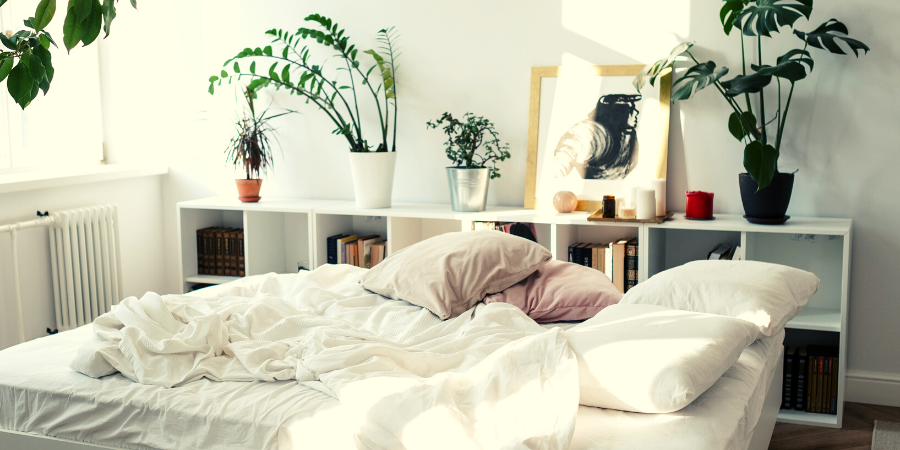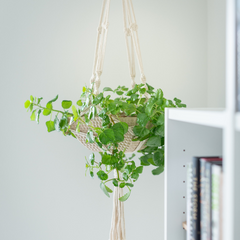Your Cart is Empty

And a really simple way to increase air purification naturally is to add certain plants around your house that just love to suck up, filter and neutralise a range of nasties, including pollutants such as formaldehyde, benzene, trichloroethylene and carbon monoxide.
We have compiled a list of 15 top air-purifying plants that you can easily acquire and will make a beautiful addition to any indoor space. If you're new to parenting plants, fear not! We have also included some tips on caring for each variety of plant.

The beautiful Kentia Palm — also known as the Thatch Palm — is a species of flowering plant native to Australia. They are incredibly resilient, elegant and have super air-purifying abilities, removing toxins such as formaldehyde, ammonia and carbon dioxide, making them the perfect choice for your home or office.
Care advice: The Kentia Palm prefers bright, indirect light but will tolerate shade. To avoid overwatering, make sure you leave the top soil to go dry first. If it isn't getting enough water, you will notice the tips of the leaves turning brown.

Devil's Ivy is perfect for keeping the air in your home clean, effortlessly purifying the air of xylene, benzene, formaldehyde and trichloroethylene. And If you're not very good with taking care of plants, this one could be your best choice as it works well in most light conditions and is almost indestructible.
Care advice: While the Devil's Ivy will thrive anywhere, they prefer brighter spots in the home. They also love moisture, so make brilliant bathroom plants. Water weekly or whenever the soil feels dry.

The Red Edged Dracaena or Madagascar Dragon Tree is on NASA's list of top 10 air cleaning plants. This amazing natural air purifier doesn't just add oxygen to your home - it filters and removes pollutants, toxins, and carcinogens including benzene, formaldehyde, trichloroethylene, xylene, and toluene.
Care advice: This plant has the potential to grow to 8ft, so keep it in a room with high ceilings and reasonable sunlight.

The plant has proven successful in removing airborne toxins within the home, including ammonia, formaldehyde, xylene, and carbon dioxide. Unlike other plants, who simply make oxygen, Rhapis excelsa will actually make the air in your home cleaner and safer to breathe.This is also one of the few plants that can help reduce levels of ammonia that can be found in a range of cleaning products. They are expensive to buy fully-grown so you might want to shop around for a smaller one or start from seed.
Care advice: Humidity-loving, this plant will be very happy in your bathroom.

This succulentplant purifies the air of formaldehyde and benzene – two chemicals commonly found in household cleaning products such as varnishes, floor finishes, and detergents – and has amazing healing properties too. It’s the perfect addition to your kitchen windowsill, enjoying the sun whilst being on hand to soothe any kitchen burns.
Care advice: This plant will thrive in a sunny location.

NASA, which tested the abilities of three common house plants to remove formaldehyde from the air, found in preliminary tests that spider plants were the champs, removing 95 percent of the toxic substance from a sealed Plexiglas chamber in 24 hours.
It will also quietly battle toxins including carbon monoxide and xylene, a solvent used in the printing and rubber industries. If you have pets, this is one of the few houseplants that is non-toxic to animals. And for those of you who are house plant newbies, the resilient spider plant is the perfect choice.
Care advice: Spider Plants enjoy bright to moderate light in ambient temperature. Once a week watering is sufficient in spring and summer. In winter, allow the soil to dry a bit more between waterings.

Like the Peace Lily, these pretty blooms help to filter out a host of toxins including formaldehyde, xylene, toluene, trichloroethylene, ammonia and benzene, which is often found in plastics, detergents, and glue.
This is definitely not a plant for pet owners, as despite its beauty, it is poisonous to cats, dogs, and even horses, as well as humans if ingested.
Care advice: This plant loves sunlight, so place it in a spot near a sunbathed window.

Also known as Mother-in-Law's Tongue, this yellow-tipped succulent releases oxygen at night, helping you to breathe better while sleeping. It is one of the best plants for filtering the air of formaldehyde, xylene, benzene, toluene, and trichloroethylene, however, it is unfortunately poisonous to cats and dogs.
Care advice: Be mindful not to overwater, as the roots are prone to rot in moist soil.

This easy-growing perennial vine is particularly effective at reducing airborne faecal particles which makes it the perfect air purifying plant for your bathroom or en suite. In addition, studies have shown that the ivy can also help combat mold levels in the home.
Care advice: Provide your English ivy with generous watering and four hours of direct sunlight a day, and it will return the love to you with clean, detoxified air.

This hardy low-maintenance house plant is one of the most popular, thanks to its striking look. A natural humidifier, aprevious study found that it had been recommended by NASA as one of the best for cleansing the air. Perfect for brightening up a desk or windowsill.
Care advice: Easy to care for, a rubber plant can grow well on low levels of light. It's worth knowing that it's toxic to dogs and cats, so be extra careful if you have one close to your pets.

Perfect for adding a pop of colour to your room, the Flamingo Lily is a great air purifying plant for beginners and city-dwellers. As well as having salmon-red, heart-shaped leaves, it's excellent at purifying the air.
Care advice: Keep your Flamingo Lily close to bright areas, but away from direct sunlight. To ensure it thrives, water yours once or twice a week. They also work particularly well in humid areas, such as the bathroom or kitchen.

With a shapely form and gracefully arching fronds, the Kimberly Queen Fern is perfect for the not-so-green-fingered as they don't require much care. Considered one of the most effective indoor air purifiers, they do exceedingly well when placed in low light areas.
Care advice: The Kimberly Queen prefers bright indirect light but can survive in full sun if watered on a regular basis. Ensure you water them every five to seven days. During the heat of the summer, they may need watering more often.

Perfect for low light conditions, the Bamboo Palm makes a beautiful focal point in any living area. Its graceful, arching leaves make great all-around air cleaners, specifically famed for removing formaldehyde from the air.
Care advice: Water regularly through the growing season, but it's advised you let the surface of the soil dry out slightly before re-watering.

A long-time favourite among house plant lovers, the Peace Lily is one of the top air purifying plants (also top of the list with NASA) as it can help filter, breakdown and neutralise toxic gases like benzene, formaldehyde and carbon monoxide. If you do plan on adding this one to your plant collection, it's worth knowing that it is poisonous to cats and dogs.
Care advice: Peace lilies can tolerate short periods of dry soil, but their leaves will start to brown if neglected for too long. To keep it thriving, place it in bright, indirect light and keep the soil consistently moist.

In a recent study, chemists at the State University of New York Oswego found bromeliads, like the Scarlet Star, to remove 80% of VOCs from the air in only 12 hours. These flowering plants love humid environments, so consider placing them in the bathroom where they can soak up the steam from your showers.
With leathery leaves and a pop of colour, the Scarlet Star Bromeliad is a beautiful houseplant that is incredibly long-lasting.
Care advice: Ensure this plant is always well watered, but never soggy. Place your plant in a location with moderate to bright light year-round, avoiding direct sunlight.
Comments will be approved before showing up.


In this blog we look at this really murky pool of information about microfiber, its Positives, Negatives, the alternatives, and how green those alternatives are.
When I say murky, I really mean really murky. You can find a bunch of info saying how bad microfibre is, written by companies that promote/ sell alternatives, and then when one starts digging into the alternatives, you learn that they are not so squeaky clean either.

We're well aware of the health risks linked to heavy metals, pesticides, and herbicides. However, many traditional household and personal care products harbor less-discussed hazardous ingredients that contribute to the toxic load in our bodies. This accumulation of toxins, termed “body burden,” can potentially disrupt hormones, compromise the immune system, and heighten sensitivity to allergens.
Here are some straightforward yet impactful ways to reduce your family's exposure to toxins this year: